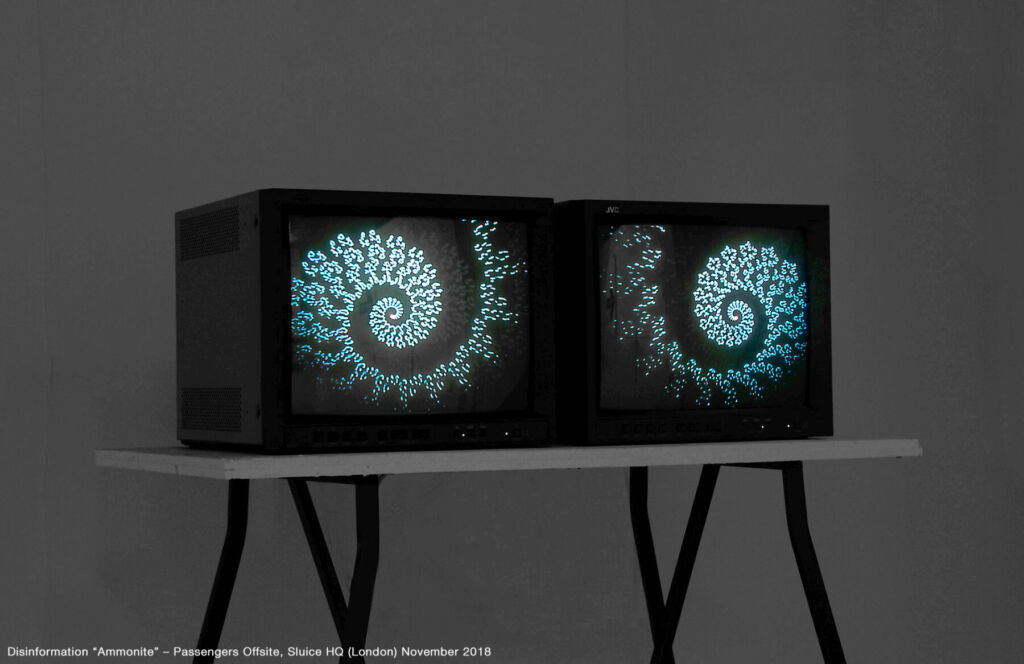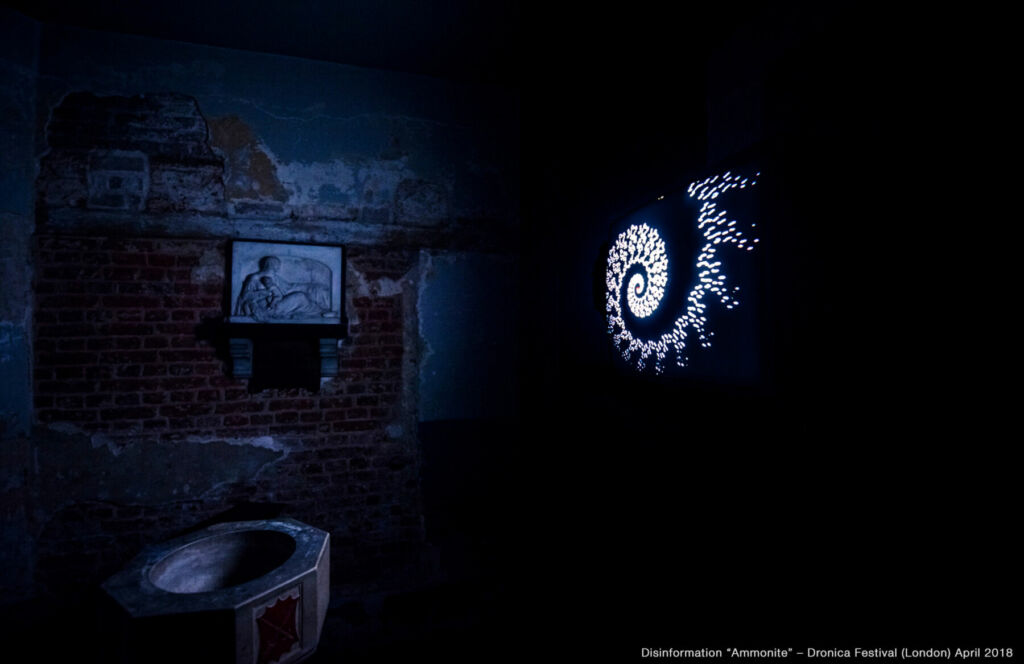Text by Joe Banks

“Fossils fascinate me – they’re like time capsules; if only one could unwind this spiral it would probably play back to us a picture of all the landscapes it’s ever seen” – J.G. Ballard “Prisoner of the Coral Deep” 1964
The “Ammonite” installation by art project Disinformation is a 15-minute long “video organism”, created using standard definition domestic TV and video equipment, in conjunction with a 632.8nm helium-neon research laser. “Ammonite” uses laboratory optical and digital film technology to create a minutely-tuned and hypnotic visual feedback loop – an optokinetic artwork, in which emergent form self-organises into the image of a gently pulsing and apparently living organism. The installation appears, at first glance, to be filmed in black-and-white, but is in fact realised in colour.
“Ammonite” was created in July 2009 and exhibited in January 2010. Since then, this artwork has, most recently, been shown at the Dronica Festival (Stoke Newington Old Church, London) in April 2018 (curated by Nicola Serra and Nicolò Becciu) [1], in the Disinformation solo exhibition at Sluice HQ (Hackney, London) November 2018 (curated by Julie Hill) [2], in the Disinformation, International Lawns and Rural College of Art group show at White Box gallery (Blackheath, London) July 2019 [3] (curated by Joe Banks, with help from Domo Baal), and is currently showing, 21 May to 16 July 2023, at the Outernet Arts exhibition space in central London (curated by Tony Tremlett) [4].
Although the “Ammonite” videos are exhibited on the smallest of the (massive) LED walls at Outernet Arts, the image is still huge – Outernet Arts is the largest digital exhibition space in Europe, and, according to The Times newspaper, one of the most popular tourist attractions in the UK [5].
As the title suggests, the “Ammonite” videos strongly resemble the coiled and moving forms of the extinct marine Ammonoidea – shell-bearing cephalopod molluscs, relatives of the modern “ink fish” – octopus, squid and cuttlefish – which evolved during the Devonian geological period, approximately 400 million years ago. The video also resembles, to an extent, the growth patterns of ferns – primordial species which also emerged during the (later) Devonian period.
In “The Origin of Species”, Charles Darwin, the father of evolutionary biology, argued that morphology – the comparative study of shapes and forms – is the “very soul” of natural history [6]; William Bateson, the inventor of the term “genetics”, stated that “a living thing is not matter” but a “vortex through which matter passes” [7]; and (as I’ve previously argued) “art is not necessarily science, but science is always art” [8][9]. The emergence and growth of the ammonite’s spiralling forms is both a product of and metaphor for evolution.

The “Ammonite” artwork was in part inspired by the (excellent) “Intraference” videos by long time Disinformation collaborator, the film-maker Barry Hale [10]. “Ammonite” can however be seen as an affectionate, even nostalgic, parody of historic video art, as versions of the technique used to create this installation have been shown as far back as the title sequence for the science fiction series “Doctor Who”, broadcast on BBC TV in 1963 [11][12]. “Ammonite” remains however unique among video feedback artworks – first, as a work of visual music, on account of the sheer delicacy and sustained precision of the system’s manual tuning, and second, most importantly, in being a work of representational (as opposed to abstract) art [13].

As the term “Devonian” implies, that period in the evolutionary time scale takes its name from the English county in which specimens identified as being from that period were first identified, and this serves to remind us that “Ammonite” is a not only an electronic genre piece, but also a work of landscape art. So, considering these ideas in terms of their relation to visual perception, it is relevant to observe that in his pioneering essay “Meanings of Landscape” the curator and naturalist Geoffrey Grigson proposed the notion that “landscape is you and me”, discussing how “we project ourselves” into an actual or painted landscape, “which then reflects our own being back to our eyes” [14]. “Meanings of Landscape” was published in 1949 in Grigson’s book “Places of the Mind”, and this book is in effect, an early example of what later became known as “psychogeography”.
Writing in 1935 for Mfanwy Evans’ art magazine “Axis”, Geoffrey Grigson coined the term “biomorphic” [15] to describe what the art historian Edward Juler calls “artworks that were neither representational nor wholly abstract, but rather appeared to owe their origins, symbolically as much as… visually, to living things” [16]. Then, in his commentary for the photographic art book “The Living Rocks”, Grigson described fossils in general as “images of life”, and the ammonite in particular as “a ghost in stone” [17].

The “Ammonite” video also strongly resembles features of the geometric figure discovered by the mathematician and communications theorist Benoit Mandelbrot – the phenomenally complex and intimidating Mandelbrot Set, suggesting that the non-linear optical feedback system used to generate this artwork also expresses a form of fractal geometry [18].
In terms of suggesting how such imagery can be perceived through the medium of video, it’s relevant to point out that (parodying the famous aphorisms of the media theorist and philosopher Marshall McLuhan) the film-maker David Cronenberg wrote (in scripted dialogue for the movie “Videodrome”) that “the television screen is the retina of the mind’s eye”, so that “whatever appears on the television screen emerges as raw experience for those who watch it” [19]. Then, as (the real) Marshall McLuhan stated “each medium is brought to the pinnacle of vortical strength, with the power to mesmerise us…” and (referring to television) “…the glowing phosphorescent eye sitting altar-like at the end of the living room is no exception” [20].

As readers of Clot Magazine may well recall, the earlier Disinformation video “Spellbound” does exactly what that title suggests – spellbinding audiences, with imagery which induces viewers to perceive the illusion of (nuclear scientist) J. Robert Oppenheimer’s EYE, burned into the “lake” of “glass” that was melted into desert sand by the heat of the world’s first atom bomb test [21]. “Spellbound” is designed to give viewers the impression that they’re not just watching this video but that this video is also watching them.
The “Ammonite” installation is equally mesmeric. First, the spirals in “Ammonite” resemble the “Hypnowheel” imagery of stage hypnosis and film noir cinema. In addition, “Ammonite” also triggers reflexes that are, at the level of evolutionary biology, hard-wired into the “deep structure” of mammalian perceptual evolution – as the twin screens of the full “Ammonite” exhibits fixate viewers with what appear to be two enormous glowing EYES (see photographs).
Since this reflex is biologically encoded, it’s not surprising that the history of cinema is littered with similar, often highly evocative, imagery, from the notorious “eye” scene in the film “Un Chien Andalou” by Salvador Dalí and Luis Buñuel, to the eyes and spirals that open “Vertigo” – imagery created for the director Alfred Hitchcock by the graphic designer Saul Bass. Among many notable examples, in the extraordinary movie “Uzumaki” (meaning, literally, “spiral”) the Ukrainian-born Japanese film director Akihiro Higuchi (aka Higuchinsky) depicts an entire landscape – based on the manga by the artist Junji Ito – infested with malevolent spirals, and the spiral is celebrated, in dramatically obsessive and macabre terms, as (quote) “the highest form of art” [22].
Footnote: Geoffrey Grigson also contributed to the legendary International Surrealist Exhibition at London’s New Burlington Galleries in June 1936, exhibiting a mysterious (and as yet unidentified) “object”, alongside works by Pablo Picasso, Joan Miró, Salvador Dalí, Henry Moore, Leonor Fini, Alberto Giacometti and Constantin Brancusi etc [23]. Incidentally, Grigson’s poem “Ammonite, Under Sun and Thyme” opens with the words “marjoram, rockrose, thyme, pun of scent and clock”, and was published in 1963 [24]. Chapter 15 of Marshall McLuhan’s “Understanding Media” is titled “Clocks: The Scent of Time”, and was published a year later [25], thereby seeming to quote (or at least paraphrase) Grigson’s “Ammonite”. The University of Toronto Thomas Fisher Rare Book Library confirms that McLuhan owned at least 3 works by Geoffrey Grigson, not listing the “Collected Poems”, but clearly showing that McLuhan was familiar with Grigson’s work [26].






